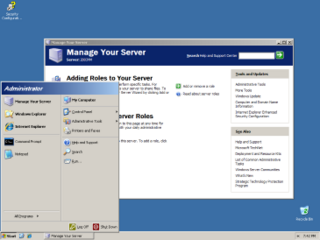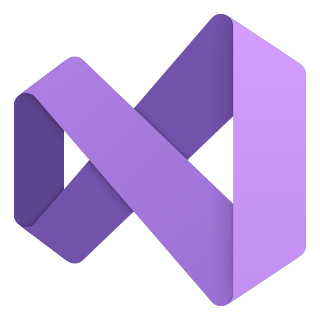
Windows XP is a major release of Microsoft's Windows NT operating system. It was released to manufacturing on August 24, 2001, and later to retail on October 25, 2001. It is a direct upgrade to its predecessors, Windows 2000 for high-end and business users and Windows Me for home users, and is available for any devices running Windows NT 4.0, Windows 98, Windows 2000, or Windows Me that meet the new Windows XP system requirements.

Windows Server 2003, codenamed "Whistler Server", is the second version of Windows Server operating system produced by Microsoft. It is part of the Windows NT family of operating systems and was released to manufacturing on March 28, 2003 and generally available on April 24, 2003. Windows Server 2003 is the successor to the Server editions of Windows 2000 and the predecessor to Windows Server 2008. An updated version, Windows Server 2003 R2, was released to manufacturing on December 6, 2005. Windows Server 2003 is based on the consumer operating system, Windows XP.
ADO.NET is a data access technology from the Microsoft .NET Framework that provides communication between relational and non-relational systems through a common set of components. ADO.NET is a set of computer software components that programmers can use to access data and data services from a database. It is a part of the base class library that is included with the Microsoft .NET Framework. It is commonly used by programmers to access and modify data stored in relational database systems, though it can also access data in non-relational data sources. ADO.NET is sometimes considered an evolution of ActiveX Data Objects (ADO) technology, but was changed so extensively that it can be considered an entirely new product.
Microsoft Servers is a discontinued brand that encompasses Microsoft software products for server computers. This includes the Windows Server editions of the Microsoft Windows operating system, as well as products targeted at the wider business market. Microsoft has since replaced this brand with Microsoft Azure, Microsoft 365 and Windows 365.
Patch Tuesday is an unofficial term used to refer to when Microsoft, Adobe, Oracle and others regularly release software patches for their software products. It is widely referred to in this way by the industry. Microsoft formalized Patch Tuesday in October 2003. Patch Tuesday is known within Microsoft also as the "B" release, to distinguish it from the "C" and "D" releases that occur in the third and fourth weeks of the month, respectively.
Microsoft BizTalk Server is an inter-organizational middleware system (IOMS) that automates business processes through the use of adapters which are tailored to communicate with different software systems used in an enterprise. Created by Microsoft, it provides enterprise application integration, business process automation, business-to-business communication, message broker and business activity monitoring.

Windows Server 2008, codenamed "Longhorn Server", is the fourth release of the Windows Server operating system produced by Microsoft as part of the Windows NT family of the operating systems. It was released to manufacturing on February 4, 2008, and generally to retail on February 27, 2008. Derived from Windows Vista, Windows Server 2008 is the successor of Windows Server 2003 and the predecessor to Windows Server 2008 R2.
Oracle Applications comprise the applications software or business software of the Oracle Corporation both in the cloud and on-premises. The term refers to the non-database and non-middleware parts. The suite of applications includes enterprise resource planning, enterprise performance management, supply chain & manufacturing, human capital management, and advertising and customer experience.
Microsoft Commerce Server is a Microsoft product for building e-commerce systems using Microsoft .NET technology.
Microsoft Visual SourceSafe (VSS) is a discontinued source control program oriented towards small software development projects. Like most source control systems, SourceSafe creates a virtual library of computer files. While most commonly used for source code, SourceSafe can handle any type of file in its database, but older versions were shown to be unstable when used to store large amounts of non-textual data, such as images and compiled executables.
Microsoft Identity Integration Server (MIIS) is an identity management (IdM) product offered by Microsoft. It is a service that aggregates identity-related information from multiple data-sources. The goal of MIIS is to provide organizations with a unified view of a user's/resources identity across the heterogeneous enterprise and provide methods to automate routine tasks.
Microsoft SQL Server Express is a version of Microsoft's SQL Server relational database management system that is free to download, distribute and use. It comprises a database specifically targeted for embedded and smaller-scale applications. The product traces its roots to the Microsoft Database Engine (MSDE) product, which was shipped with SQL Server 2000. The "Express" branding has been used since the release of SQL Server 2005.

Microsoft Customer Care Framework (CCF) was a desktop-based framework which was used to address issues faced by service providers caused by multiple line of business (LOB) systems while interacting with their customers. It was discontinued though many of its core functions were moved to an add-in for the Microsoft Dynamics CRM product named the Unified Service Desk.

Visual Studio is an integrated development environment (IDE) from Microsoft. It is used to develop computer programs including websites, web apps, web services and mobile apps. Visual Studio uses Microsoft software development platforms such as Windows API, Windows Forms, Windows Presentation Foundation, Windows Store and Microsoft Silverlight. It can produce both native code and managed code.

Windows Server 2008 R2, codenamed "Windows Server 7", is the fifth version of the Windows Server operating system produced by Microsoft and released as part of the Windows NT family of operating systems. It was released to manufacturing on July 22, 2009, and became generally available on October 22, 2009, shortly after the completion of Windows 7. It is the successor to Windows Server 2008, which is derived from the Windows Vista codebase, released the previous year, and was succeeded by the Windows 8-based Windows Server 2012.
Microsoft Host Integration Server is a gateway application providing connectivity between Microsoft Windows networks and IBM mainframe and IBM i systems. Support is provided for SNA, 3270, 5250, CICS, APPC, and other IBM protocols. Support is also provided for advanced integration with Windows networks and software, such as linking Microsoft Message Queuing applications to IBM WebSphere MQ, binding Microsoft DTC transactions with CICS, and cross-protocol access to Db2 databases on IBM platforms.
Sitecore is a customer experience management company that provides web content management, and multichannel marketing automation software. The company was founded in 2001 in Denmark.

Microsoft started development on the .NET Framework in the late 1990s originally under the name of Next Generation Windows Services (NGWS). By late 2001 the first beta versions of .NET Framework 1.0 were released. The first version of .NET Framework was released on 13 February 2002, bringing managed code to Windows NT 4.0, 98, 2000, ME and XP.
Microsoft Dynamics 365 is a product line of enterprise resource planning (ERP) and customer relationship management (CRM) intelligent business applications announced by Microsoft in July 2016 and released on November 1, 2016. It was formerly Microsoft Dynamics.
The history of Microsoft SQL Server begins with the first Microsoft SQL Server database product – SQL Server v1.0, a 16-bit relational database for the OS/2 operating system, released in 1989.





